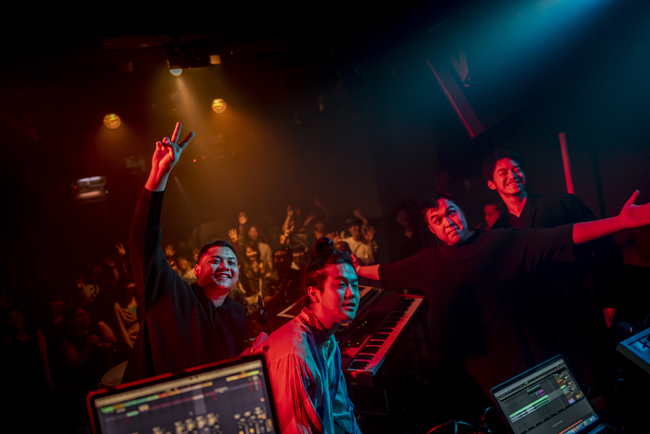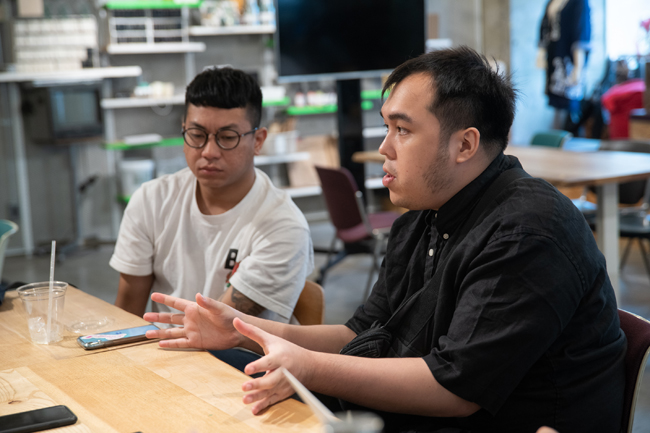The Early Days of Bordering Practice
Patrick: I wanted to rewind a bit and talk about Bordering Practice's origins. It started in 2016. When was the first time each of you were approached about it?
tomad: The research activity started in 2016. The first place I went to visit was Manila. Next, I had the opportunity to go to Jakarta. First, in Manila, I met with Moon Mask*1, as we had known one another from the internet. I thought he was very interesting. I asked him to introduce me to labels and musicians in that arena. Then I met with similarobjects because of that. When I first visited, I went to an event. It had a good atmosphere, and the quality of the music was very high. I was pleasantly surprised to see such a great scene there. In Jakarta, I did online research first and discovered Double Deer*2. I found it through Bandcamp as a tag. I found the site, and it looked so cool. Then I actually went to see it and it was very high-class. [Laughs] I heard numerous presentations and got a sense of their vision. I found the whole thing interesting—both the creative and business sides.
*1 Moon Mask appeared in the Liquid Asian Pop Scene talk and Neo Asian Pop Showcase live music event, both in 2016.
*2 Double Deer is a record label based in Jakarta, Indonesia. Its numerous artists include KimoKal and Mantra Vutura.
similarobjects: I met them in 2016. Like tomad said, they were on a research trip to Manila, and I was introduced to him by Moon Mask. We went around and talked about the scene in Manila, I showed them around and put some shows on for them as well. We talked about how to continue the project. Then I joined a research trip to Indonesia. That's when we met Double Deer and started talking about what they are doing for the scene.
Rezky: I remember that tomad, similarobjects, HIROTA Fumi (of the Japan Foundation Asia Center), and a few other people went to Double Deer, and that Fumi contacted me asking if some artists could come to our studio. After that, the Japan Foundation Asia Center invited one of our artists, KimoKal, to play at Shibuya WWW X. After the performance, I told her we wanted to continue doing this kind of stuff. I had an idea to do music together, with musicians from different countries. So we took it from there... and it became a reality in 2019.

Photo: Jun Yokoyama
Patrick: What were your first impressions of Double Deer?
similarobjects: I thought it was interesting to see some sort of community. They have this building, which has all these different functions. Initially, it was interesting to see them as a label that also knew how to operate as a business. There was a balance. They were so professional about everything. They even had a presentation. [Laughs]
Patrick: Like on PowerPoint?
Rezky: Yeah, like a deck. [Laughs]
similarobjects: Other people we met were just about having a casual conversation. Double Deer also like to have casual conversations. But we thought that they knew what they were doing, that they knew their position in the music scene. You could feel this. I was most inspired by their ability to maintain a good balance between business and cultural promotion, not to mention their sustainable business model.
tomad: While Double Deer runs artist management and production services, they also function as a label. On top of that, they offer an educational program as well. All of these operations are at their facility that has its own studio. I don't think there is any agency or label in Japan that manages such multifaceted operations to this extent, or at least does it as casually and smoothly as Double Deer. From the perspective of the Japanese music industry, they have a unique business model.

Patrick: Before this project started, what was your exposure to or knowledge of other electronic music communities across the continent?
Rezky: Not really much in Asia, I guess. I don't know. Maybe I'm just too lazy. [Laughs]
similarobjects: When I dig around for music, it's scattered. I don't really think about the location. So I have bits and pieces of everything. I knew Zoom Lens, Maltine Records, and PARKGOLF. I knew a lot of them, but wouldn't zone it in on a specific country per se. Because of Bordering Practice, it made me more interested and want to discover more, both in terms of the participants and nonparticipants from those countries.
tomad: I had been running a label for a long time, and was always researching new things. Or things I didn't know. I tended to listen to artists from Europe or the United States. Until I got involved with this project, I wasn't really focusing on Asian music. I didn't even know what the scenes would look like. I felt like there might be nobody, like it would just be a barren land. [Laughs] But the reality was the opposite. There were just so many interesting things going on.
Building Collaboration
Patrick: How else has Bordering Practice evolved over these past three years from your perspectives?
similarobjects: I think the residency program gave it a physical form. Everything prior to that was just shows, but actually connecting on that level, I feel, is the most important, because you really get to blur the lines, to remove the borders. Even the music from this project represents all of the cultures involved; it has a little bit of everything. I think that was the highlight for me.
Rezky: For me, what's surprising is those three tracks that these guys made in Jakarta. They sound like nothing else.
similarobjects: It's like a whole new thing.

Photo: Jun Yokoyama
Patrick: What are the biggest lessons you've learned from Bordering Practice so far?
tomad: In terms of the entire project, within the individual music scenes of Southeast Asia, I was able to see so many artists and groups that are very active, in each individual city. Until I got involved with Bordering Practice, I was only focusing on the Tokyo scene. But through this project I got to get to know much more about the music communities in Asia, and that enables me to make comparisons. And this then helps me learn more about my own music scene here in Tokyo.
Double Deer sprung up around a scene that has come up in the last five years, I think. In Tokyo, there's the generation older than me, not to mention even older generations before that. There's a long and rich history of electronic music in this city, and sometimes it can be a burden to have that legacy looming over you. I sometimes feel envious when I see artists performing in a more liberated way, not held down by tradition. On the other hand, Tokyo does have a very rich fan base for electronic music. And there's so many venues you can play at here.
similarobjects: What I learned was that there is a lot in common among the different locations, but also a lot of differences. It was a very interesting reference point for somebody like myself, who is trying to build culture in Manila. It also makes me feel more confident about the music in Southeast Asia in general. In Manila, everyone praises the West. The music scene worships the West. Being able to experience Tokyo, Jakarta, Ho Chi Minh City, Hanoi, and all of these other countries made me realize that there is something very strong about the bubbling scenes here. It's starting to make me look at us as a whole, rather than just as little pockets. It's a huge thing to be together. Other than that, it was great to learn how other countries use technology in their music. How they spread and disseminate it. For example, how people in Jakarta use Instagram. It helps me understand where I fit, where my collective fits, and where we all fit on a global scale.







